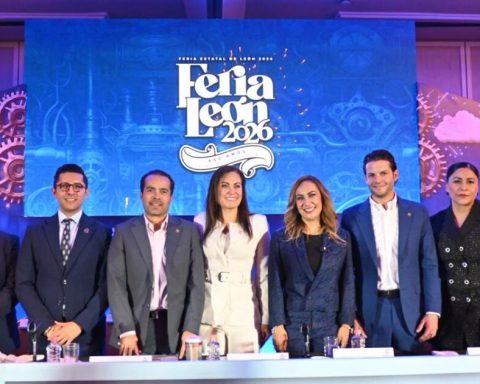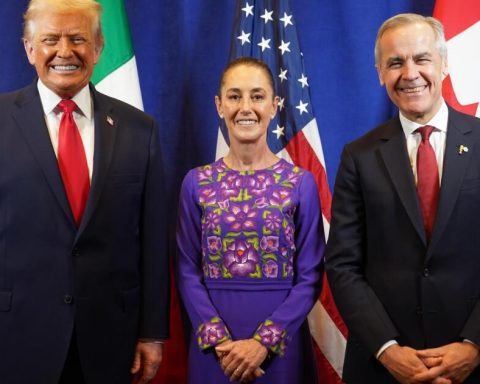Mexico beat China
In 2017, China was the origin of 21% of imports from the United States and Mexico the second largest commercial partner, but only represented about 13% of its imports, just above Canada, with 12.43%.
By 2023, things changed. Now Mexico beat the Asian giant as the main origin of American imports. This is because most of the tariffs promoted Trump against China remained during the mandate of Joe Biden, benefiting Mexican exporters.
Mexico, on the other hand, became increasingly dependent on US purchases. And now more than 82% of Mexican exports have as its origin, about 3 percentage points more than in 2017.
2018 vs. tariffs 2025 tariffs
In June 2018, Donald Trump decided to impose tariffs on Mexican imports of aluminum and steel, 10 and 25%, respectively. Mexico’s economy was not the only victim, in that first period of Trump, Canada, Turkey, China and the European Union also faced this type of measures.
The US president, at that time, argued that tariffs were necessary to return jobs to manufacturing and strengthen the working class of his country, as well as protect national security, stop drug trafficking and also to renegotiate trade agreements that he considered unfair to your country.
In more symbolic terms, Trump ordered the construction of a border wall, between Mexico and the United States.
Mexico’s response
In July 2018, Mexico retaliates against the United States, imposing tariffs on goods with value of 3,000 million dollars. The main affected products were pork, apples, blueberries and American potatoes. But rates were also applied to the importation of manufactures.
Subsequently, there was a second stage of reprisals, by raising tariffs on these products from 20 to 25%.
Mexican aluminum and steel tariffs ended on May 17, 2019. After almost a year of “commercial war”. But uncertainty did not end there. At the end of that same month, Donald Trump revealed his intention to impose a 5% tariff on all imports from Mexico, and threatened to increase them up to 25%, if Mexico did not solve the “problem of illegal immigration.”
2025 tariffs, the difference is the cartels
Donald Trump waited less time to impose tariffs on his second term. On February 1, the Executive Order made official to implement 25% rates to all imports from Mexico and Canada and 10% to those of China.
Trump argued that the three countries were responsible for the flow of fentanyl to the United States. Therefore, the President used the International Emergency Emergency Powers Law, a local law that allows freezing and blocking transactions in response to unusual and extraordinary threats outside the US.
And, in fact, this time Trump accused the Mexican government of having a complicity with drug trafficking cartels, now considered as terrorist organizations. This is one of the main differences with its first mandate.
So much so that the president of Mexico, Claudia Sheinbaum, agreed to send 10,000 elements of the National Guard to the border with the United States in order to avoid drug transfer and illegal immigration. Only in this way could he postpone, for a month, the implementation of tariffs, originally scheduled for February 4, 2025.
In return, the United States promised to face high -power arms traffic towards Mexico, a demand that comes from the six -year period of Andrés Manuel López Obrador. In addition, both governments will create work tables with health and safety officials.
The Prime Minister of Canada, Justin Trudeau also managed to negotiate with Donald Trump and promised to create a joint attack force with the United States, to combat fentanyl traffic. To do this, it will also name an anti -drug tsar. In addition, as Trump did, it will include drug trafficking cartels in the list of terrorist organizations.
Consequences of the first onslaught
Almost seven years since Trump imposed the first tariffs on Mexico, steel and aluminum. Mexico gained greater relevance in the production chains of different sectors, mainly the automaker. One of the main consequences of that first attack was the renegotiation of NAFTA, which would eventually be known as the T-MEC.
The T-MEC was signed on November 30, 2018 and covered new chapters and sectors, such as digital trade and greater integration of the automotive industry, demanding that 75% of a vehicle must be manufactured in North America. In addition, better regulations were required in environmental terms, anti -corruption, working conditions and competitiveness.
The tariffs to China, which have mostly persisted since 2018, benefited the Mexican export sector. Until the first half of 2019, Taiwan and Mexico together absorbed 36% of the “trade deviation effect”, that is, the hole left by Chinese exports to the United States, according to a study of the Bank of the Netherlands.
Another of the consequences of the tariffs, in the first period of Trump was that, in 2019, Mexico also sent 27,000 elements of the newly created national guard to the border, to contain the migratory flow, both on the southern border, as in the north.
“Benefits” for Americans
According to an analysis carried out by the Federal Reserve, Trump’s tariff more than a year of its implementation.
And not only that, the data suggests that the impulse to employment that could be observed by the protection of certain industries was more than compensated for negative effects on the most exposed manufactures of imports. That is, there was a greater relative unemployment in the manufacturing sectors that depended the most in the supplies from abroad.














